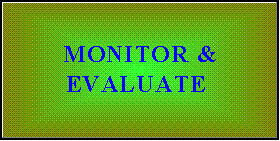
FACTORS IN MONITORING AND EVALUATING
There are some problems with monitoring
and evaluating Telework, but because of the essentially informatic nature of
the work, there is also a huge amount of information for the organisation, if
it has designed its processes correctly.
Managing at a distance, but monitoring remotely.
Virtually everything the Teleworker does can be monitored, recorded and measured, if required. The challenge is to design Management Information Systems ( MIS ) which capture the essential data without overloading the system, and the managers ! A fundamental review of processes should occur, enabling appropriate level systems to be implemented.
Remember that underpinning the move to
Telework is a philosophy of empowerment, of delegating responsibility to
operational levels. The MIS should complement this, giving meaningful
management data to the person managing the work - the Teleworker. At
operational level the system should be geared more towards outputs than inputs.
If the data shows that individual workers are operating in less than optimum
ways, eg starting late then rushing to finish, so what ! That is their choice.
Take that option away from them they will soon think that they might as well go
back to the old ways.
Monitoring for a purpose.
The very purpose of monitoring and
management checks is being questioned in modern organisations. This may be a
reaction to the previous culture of " check everything twice ". But
in times of quality initiatives, right-first-time and lean production we are
questioning the cost, and therefor value of checking. Implementing new
procedures when applying Teleworking gives organisations an opportunity to
decide what it wants to check and why, and then design the checks which are
appropriate to meet that need.
Evaluation.
It is tempting to implement a scheme and then move on to the next big thing. That way denies opportunities to learn from our experience. Although it can be difficult to evaluate the effect of projects it remains worthwhile. The business case for Teleworking has been generally made - projects report such findings as ;
UK Lloyds/TSB Pay back per worker per
year 9,200
UK Britannia B.S. Productivity increase by up to 40%
SCAN Average productivity increase 13%
These results need to be reflected in your business, or the investment will have been for nothing. New instruments and tools re being produced all the time to assist in the difficult task of evaluating IT investments, including EFFECT, a PC package designed for user's own evaluation activity by NUTEK in Sweden.
Last Updated on 11 December2002 by COLIN TIERNEY